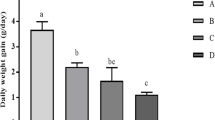Summary
Daily oral administration of 20 or 60 mg/kg chlorphentermine for 1 week produced a dose-related increase in the number of myeloid bodies in renal tissue of both adult and newborn rats. In adults myeloid bodies were present throughout the kidney while in neonates these bodies were found predominantly in the medullary region. Simultaneous administration of phenobarbital and either chlorphentermine dose resulted in a reduction in the number of myeloid bodies in kidneys of adults and newborns. Our data show that phenobarbital prevented the chlorphentermine-induced lipidosis in renal tissue and that newborns appear less sensitive than adults to the histopathologic action of anorectic on kidney.
Similar content being viewed by others
References
Hruban Z, Slesers A, Hopkins E (1972) Drug-induced and naturally occurring myeloid bodies. Lab Invest 27:62–70
Kacew S, Narbaitz R (1977) A comparative ultrastructural and biochemical study between the effects of chlorphentermine and phentermine on rat lung. Exp Mol Pathol 27:106–120
Kacew S, Narbaitz R (1978) Early metabolic alterations in pulmonary tissue following administration of toxic agents. Fed Proc 37:2489–2495
Kacew S, Narbaitz R, Dubas TC (1979) Biochemical and morphologic investigation of the influence of chlorphentermine and subsequent withdrawal on newborn rat lung. Toxicol Appl Pharmacol 47:185–191
Karabelnik D, Zbinden G, Baumgartner E (1974) Drug-induced foam cell reactions in rats: I. Histopathologic and cytochemical observations after treatment with chlorphentermine, RMI 10.393 and Ro 4-4318. Toxicol Appl Pharmacol 27:395–407
Karnovsky MJ (1965) A formaldehyde-glutaraldehyde fixative of high osmolality for use in electron microscopy. J Cell Biol 27:137–138A
Kosek JC, Mazze RI, Cousins MJ (1974) Nephrotoxicity of gentamicin. Lab Invest 30:48–57
Lüllmann-Rauch R (1975) Lipidosislike renal changes in rats treated with chlorphentermine or with tricyclic antidepressants. Virchows Arch [Cell Pathol] 18:51–60
Read WK, Bay WW (1971) Basic cellular lesion in chloroquine toxicity. Lab Invest 24:246–259
Reynolds ES (1963) The use of lead citrate at high pH as an electron-opaque stain in electron microscopy. J Cell Biol 17:208–212
Shikata T, Kanetaka T, Endo Y, Nagashima K (1972) Drug-induced generalized phospholipidosis. Acta Pathol Jap 22:517–531
Svendsen O (1977) The effect of phenobarbital on chlorphentermine-induced alveolar foam cells in rats. Toxicol Appl Pharmacol 40:171–173
Author information
Authors and Affiliations
Rights and permissions
About this article
Cite this article
Kacew, S., Narbaitz, R. The effect of phenobarbital on chlorphentermine-induced lipidosis-like alterations in renal tissue of adult and newborn rats. Virchows Archiv B Cell Pathol 36, 59–63 (1981). https://doi.org/10.1007/BF02912055
Received:
Accepted:
Issue Date:
DOI: https://doi.org/10.1007/BF02912055




